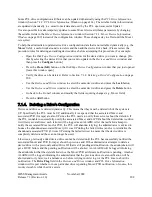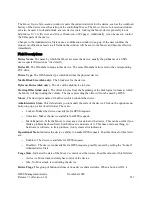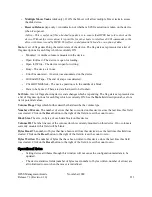
Advice - This option is supported for 3590, 3590E, 3580, 3592, 9840, 9940, DST-312, DST-314,
T10000 and GY-8240 devices.
•
NO-DELAY
Support
(tape only)
.
An indication of whether the device supports opening the device
with no delay flag set, while allowing tape I/O operation after the open.
Advice - On some tape devices, this will allow for a quicker polling operation when no tape is
presently loaded in the device. This field is meaningful for tape devices only.
•
Write TM(0) to Sync
(tape only)
.
An indication of whether the device supports issuing a write
tape mark request with a zero count to flush data written previously to the tape media.
Advice - On some devices, this may provide a higher performance method to ensure that data has
been safely written to the media. This option is not used for the IBM 3590 and 3590E devices,
provided the HPSS supported device driver is used in accessing the device. Note that for Ampex
DST-312 this field should be set to “ON”.
•
Removable Media Support
(tape only)
.
An indication of whether the device supports removable
media.
•
SCSI-2 LBA Positioning
(tape only). If ON, the tape device supports SCSI-2 Logical Block
Addresses.
Advice - If SCSI-2 LBAs and the SCSI LOCATE command (Locate Support) are supported by the
device, HPSS will calculate tape read addresses based on known LBAs and relative addresses.
LBA positioning provides for faster access of data residing on tape. The benefit will be realized
for read requests with many source descriptors specifying locations spread sparsely down the
tape. This is supported only by the IBM SCSI tape device driver.
•
SAN3P-transfer Enabled
(disk only). If ON, SAN3P data transfers to this device will be
supported.
Warning
– There is a security vulnerability associated with the use of SAN3P. If a user is root on
a machine which has access to the SAN (e.g. a client machine) then that user has the potential to
access or destroy fiber-channel connected disk storage.
Two areas of concern: 1) verification
that only authorized users (usually limited to only ‘root’ or ‘hpss’) are granted read and
write access to these resource; 2) HPSS administrators should be aware that machines,
possibly owned or managed by other groups, which are added to the SAN to facilitate the
use of SAN3P transfers will have access to all data on disk and tape resources. If those
systems are compromised, or there are individuals authorized for systems privileges on
those particular machines, but not necessarily authorized for HPSS administrative access,
there is the potential for access and/or damage to HPSS data. These are inherent
limitations of SAN implementations that have not yet been addressed by the industry and
cannot be remedied by HPSS.
•
Multiple Mover Tasks
(disk only). If ON, the Mover will allow multiple Mover tasks to access
the disk device.
•
Reserve/Release
(tape only). An indication of whether a SCSI reservation is taken on the device
when it's opened.
Advice - This is useful on fiber attached tape devices to ensure that HPSS has sole control on the
HPSS Management Guide
November 2009
Release 7.3 (Revision 1.0)
200
Summary of Contents for RELEASE 7.3
Page 14: ...HPSS Management Guide November 2009 Release 7 3 Revision 1 0 14...
Page 195: ...HPSS Management Guide November 2009 Release 7 3 Revision 1 0 195...
Page 210: ...HPSS Management Guide November 2009 Release 7 3 Revision 1 0 210...
Page 215: ...HPSS Management Guide November 2009 Release 7 3 Revision 1 0 215...
Page 222: ...HPSS Management Guide November 2009 Release 7 3 Revision 1 0 222...
Page 266: ...HPSS Management Guide November 2009 Release 7 3 Revision 1 0 266...
Page 293: ...HPSS Management Guide November 2009 Release 7 3 Revision 1 0 293...
Page 367: ...HPSS Management Guide November 2009 Release 7 3 Revision 1 0 367...
Page 372: ...HPSS Management Guide November 2009 Release 7 3 Revision 1 0 372...
Page 384: ...HPSS Management Guide November 2009 Release 7 3 Revision 1 0 384...
Page 388: ...HPSS Management Guide November 2009 Release 7 3 Revision 1 0 388...
















































